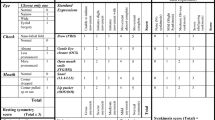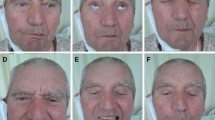Abstract
Background
Evidence of a high interobserver variability of the subjective House-Brackmann facial nerve grading system (HBGS) would justify cost- and time-consuming technological enhancements of objective classifications for facial nerve paresis.
Method
A total of 112 patients were recruited for a randomized multi-center trial to investigate the efficacy of prophylactic nimodipine treatment in vestibular schwannoma (VS) surgery. For the present investigation both treatment groups were pooled for the assessment of facial nerve function preoperatively, in the early postoperative course and 1 year after the surgery. Facial nerve function was documented photographically at rest and in motion and classified according to the HBGS by three independent observers (neurosurgeon, neurologist, ENT) and by the investigator of each center.
Results
Interobserver variability was considerably different with respect to the three time points depending upon the severity of facial nerve paresis. Preoperative facial nerve function was normal or only mildly impaired (HB grade I or II) and was assessed consistently in 97%. Facial nerve function deteriorated during the early postoperative course and was subsequently documented without dissent in only 36%, with one grade difference in 45%, two grade difference in 17% and three grade difference in 2%. One year after surgery, facial nerve function predominantly improved resulting in a consistent assessment in 66%. Differing ratings were observed in 34% with one grade deviation in 88% and of two grades in 12%. Patients with differing ratings of two or more grades exhibited considerably worse facial nerve function (p < 0.001).
Conclusions
The HBGS produced comparable results between different observers in patients with normal or only mildly impaired facial nerve function. Interobserver variability increased depending on the severity of facial nerve paresis. The results suggest that the HBGS does not promote uniformity of reporting and comparison of outcomes in patients with moderate or severe facial nerve paresis.



Similar content being viewed by others
References
Ahrens A, Skarada D, Wallace M, Heung JY, Neely JG (1999) Rapid simultaneous comparison system for subjective grading scales for facial paralysis. Am J Otol 20:667–671
Alicandri-Ciufelli M, Piccinini A, Grammatica A et al (2013) A step backward: the “Rough” facial nerve grading system. J Craniomaxillofac Surg 41:175–179
Burres SA, Fisch U (1986) The comparison of facial nerve grading systems. Arch Otolaryngol Head Neck Surg 112:755–758
Coulson SE, Croxon GR (1995) Assessing physiotherapy rehabilitation outcomes following facial nerve paresis. Aust J Otolaryngol 2:20–24
Coulson SE, Croxon GR, Adams RD, O’Dwyer NJ (2005) Reliability of the “Sydney”, “Sunnybrook”, and “House Brackmann” facial grading systems to assess voluntary movement and synkenesis after facial nerve paralysis. Otolaryngol Head Neck Surg 132:543–549
Croxon G, May M, Mester SJ (1990) Grading facial nerve function: House-Brackmann versus Burres-Fisch methods. Am J Otol 11:240–246
de Ru JA, Braunius WW, van Benthem PP, Busschers WB, Hordijk GJ (2006) Grading facial nerve function: why a new grading system, the MoReSS, should be proposed. Otol Neurotol 27:1030–1036
Fattah AY, Gurusinghe AD, Gavilan J et al (2015) Facial nerve grading instruments: systematic review of the literature and suggestion for uniformity. Plast Reconstr Surg 135:569–579
Gordon AS, Westrick AC, Falola MI et al (2012) Reliability of postoperative photographs in assessment of facial nerve function after vestibular schwannoma resection. J Neurosurg 117:860–863
Henstrom DK, Skilbeck CJ, Weinberg J, Knox C, Cheney ML, Hadlock TA (2011) Good correlation between original and modified House Brackmann facial grading systems. Laryngoscope 121:47–50
House JW (1983) Facial nerve grading system. Laryngoscope 93:1056–1069
House JW, Brackmann DE (1985) Facial nerve grading system. Otolarangol Head Neck Surg 93:146–147
Kanerva M, Poussa T, Pitkäranta A (2006) Sunnybrook and House-Brackmann facial grading systems: intrarater repeatability and interrater agreement. Otolaryngol Head Neck Surg 135:865–871
Kang TS, Vrabec FT, Giddings N, Terris DJ (2002) Facial nerve grading systems (1985–2002): beyond the House-Brackmann scale. Otol Neurotol 23:767–771
Kanzaki J, Tos M, Sanna M, Moffat DA (2003) New and modified reporting systems from the consensus meeting on systems for reporting results in vestibular schwannoma. Otol Neurotol 24:642–649
Kecskes G, Jori J, O’Reilly BF, Viharos L, Rovo L (2011) Clinical assessment of a new computerized objective method of measuring facial palsy. Clin Otolaryngol 36:313–319
Landis JR, Koch GG (1977) The measurement of observer agreement for categorical data. Biometrics 33:159–174
Lee NL, Susarla SM, Hohman MH et al (2013) A comparison of facial nerve grading systems. Ann Plast Surg 70:313–316
Meier-Gallati V, Scriba H, Fisch U (1988) Objective evaluation scaling of facial nerve function based on area analysis (OSCAR). Otolaryngol Head Neck Surg 118:545–550
Murty GE, Diver JP, Kelly PJ, O’Donoghue GM, Bradley PJ (1994) The Nottingham system: objective assessment of facial nerve function in the clinic. Otolarangol Head Neck Surg 110:156–161
Neely JG, Wang KX, Shapland CA, Sehizadeh A, Wang A (2010) Computerized objective measurement of facial motion: normal variation and test-retest reliability. Otol Neurotol 31:1488–1492
O’Reilly BF, Soraghan JJ, McGrenary S, He S (2010) Objective method of assessing and presenting the House-Brackmann and regional grades of facial palsy by production of a facogram. Otol Neurotol 31:486–491
Rickenmann J, Jaquenod C, Cerenko D, Fisch U (1997) Comparative value of facial nerve grading systems. Otolaryngol Head Neck Surg 117:322–325
Ross BG, Fradet G, Nedzelski JM (1996) Development of a sensitive clinical facial grading system. Otolaryngol Head Neck Surg 114:380–386
Samii M, Gerganov V (2013) Surgery of cerebellopontine lesions, 1st edn. Springer, Heidelberg, pp 147–314
Scheller C, Wienke A, Tatagiba M et al (2016) Prophylactic nimodipine treatment for cochlear and facial nerve preservation after vestibular schwannoma surgery: a randomized phase III trial. J Neurosurg 124:657–664
Scriba H, Stoeckli SJ, Veraguth D et al (1999) Objective evaluation of normal facial nerve function. Ann Otol Rhinol Laryngol 108:641–644
Smith IM, Murray JA, Cull RE et al (1992) A comparison of facial grading systems. Clin Otolaryngol 17:303–307
Vrabec JT, Backous D, Dyalilian H et al (2009) Facial nerve grading system 2.0. Otolaryngol Head Neck Surg 140:445–450
Yuen K, Inokuchi I, Maeta M, Kawakami SI, Masuda Y (1997) Evaluation of facial palsy by moire topography index. Otolaryngol Head Neck Surg 117:567–572
Acknowledgements
We thank Monika Göttlich, Jenny Hampel, Melanie Querfurt, Cornelia Seiffert and Christin Zöller, study nurses, for administrative contributions and assistance in performing this study.
Author information
Authors and Affiliations
Corresponding author
Ethics declarations
Registration and protocol
The multi-center study was registered before starting enrollment with the EudraCT number 2009-012088-32; KKSH-66; DRKS 00000328 and with the name "AkNiPro."
Funding
No funding was received for this research.
Conflict of interest
All authors certify that they have no affiliations with or involvement in any organization or entity with any financial interest (such as honoraria; educational grants; participation in speakers’ bureaus; membership, employment, consultancies, stock ownership, or other equity interest; and expert testimony or patent-licensing arrangements), or non-financial interest (such as personal or professional relationships, affiliations, knowledge or beliefs) in the subject matter or materials discussed in this manuscript.
Ethical approval
All procedures performed in studies involving human participants were in accordance with the ethical standards of the institutional and/or national research committee and with the 1964 Helsinki Declaration and its later amendments or comparable ethical standards.
Informed consent
Informed consent was obtained from all individual participants included in the study.
Rights and permissions
About this article
Cite this article
Scheller, C., Wienke, A., Tatagiba, M. et al. Interobserver variability of the House-Brackmann facial nerve grading system for the analysis of a randomized multi-center phase III trial. Acta Neurochir 159, 733–738 (2017). https://doi.org/10.1007/s00701-017-3109-0
Received:
Accepted:
Published:
Issue Date:
DOI: https://doi.org/10.1007/s00701-017-3109-0




